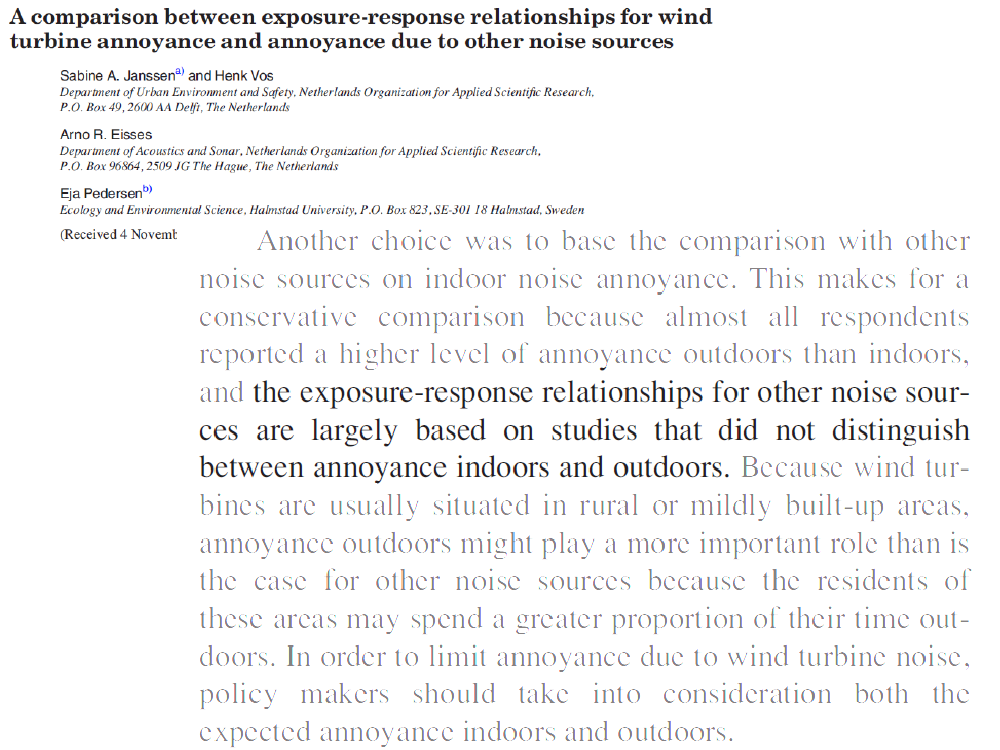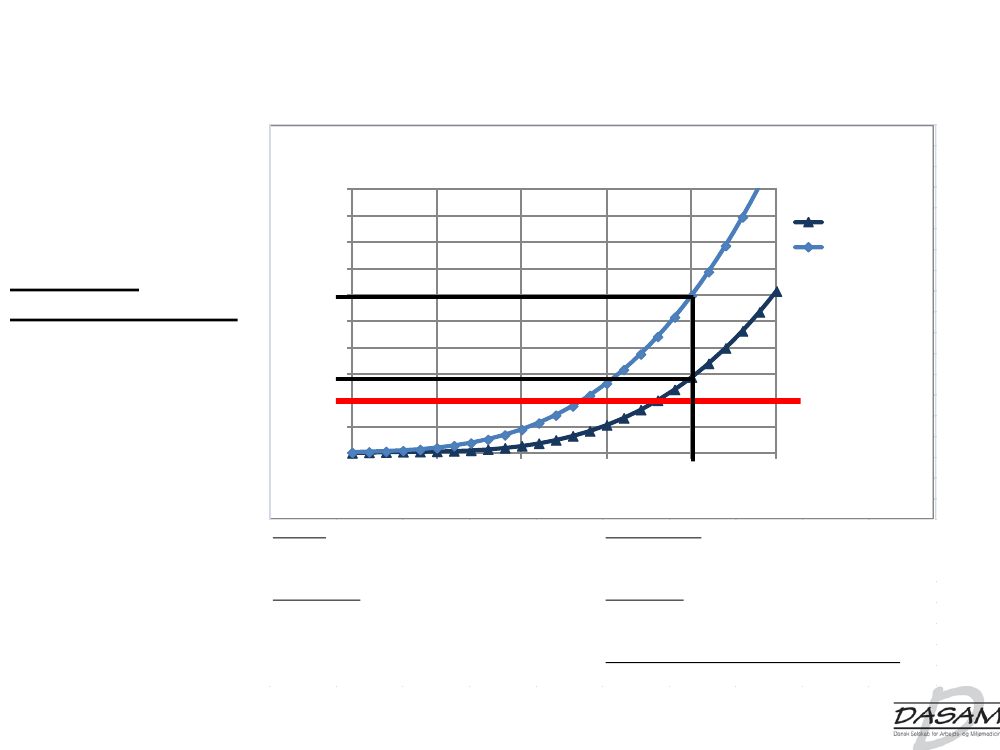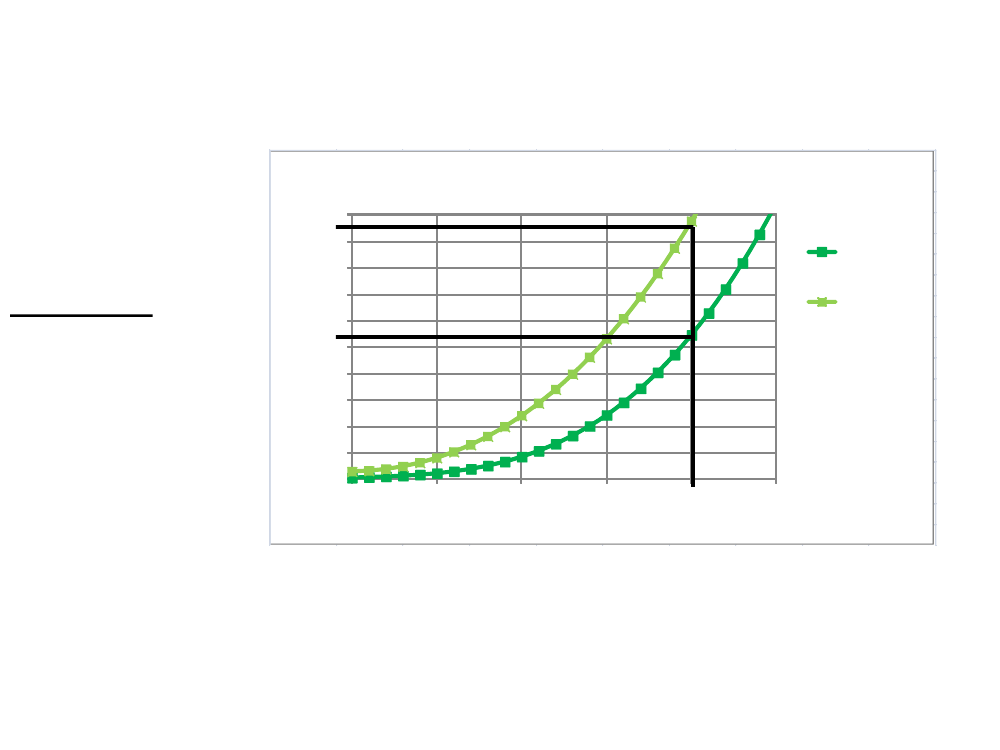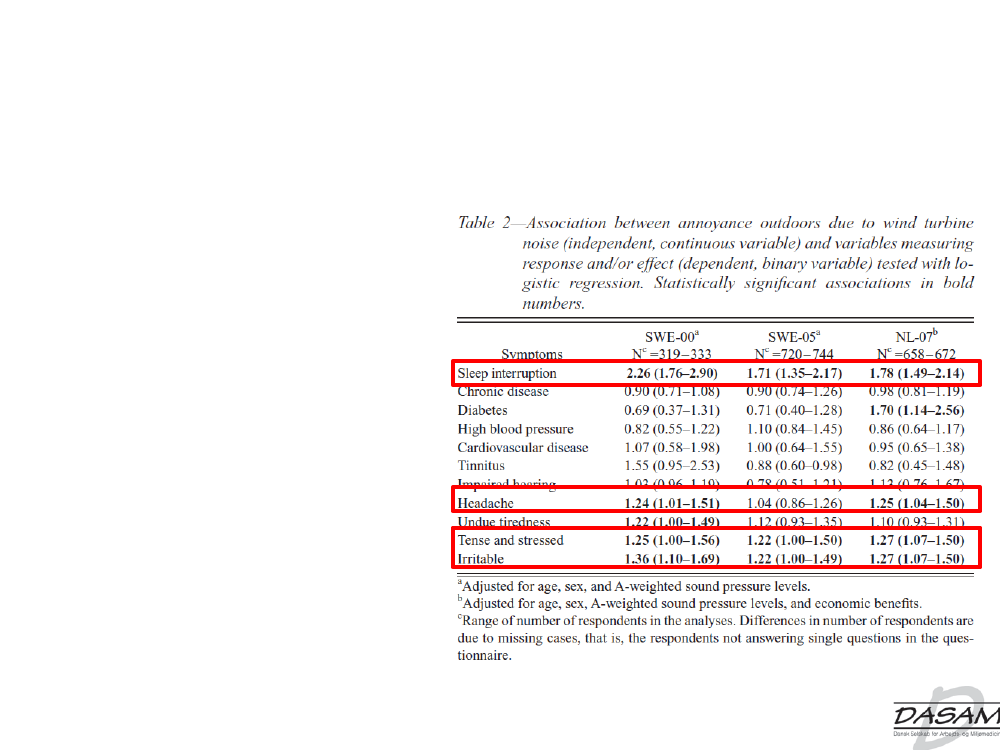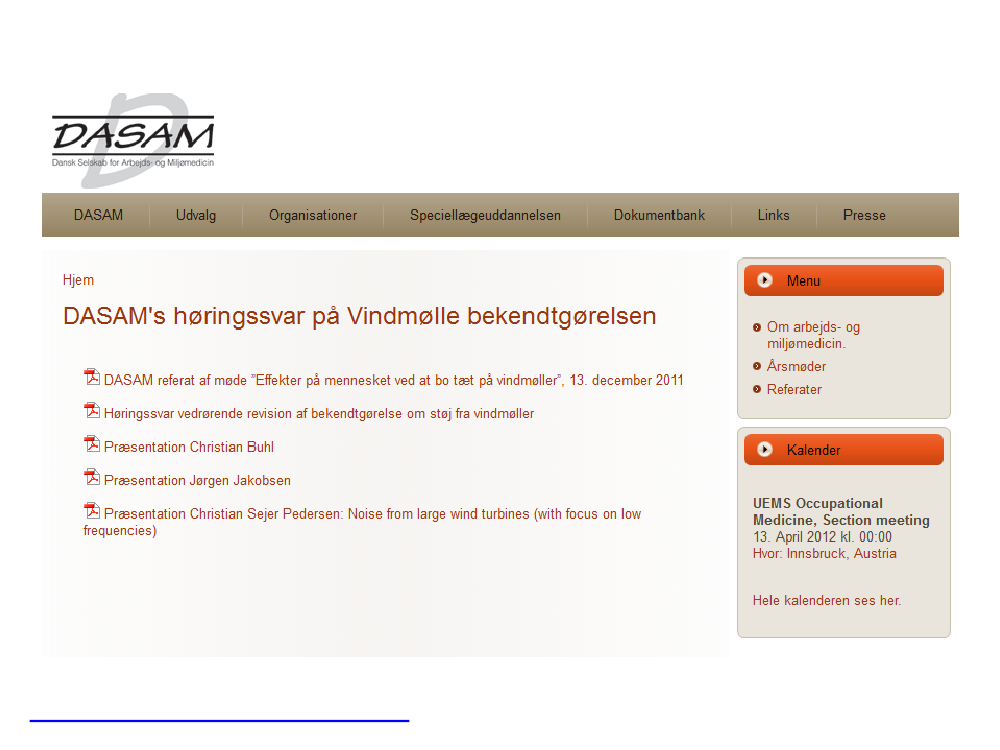Udvalget for Landdistrikter og Øer 2012-13
ULØ Alm.del Bilag 6
Offentligt
Dosis/respons-kurver for vej-, tog-,industri- og vindmøllestøjHvor mange % af naboerne kan forventes at være ”stærkt”generet ved en given støjbelastning?1 ”märker/hör inte”Do not notice2 ”märker, men störs inte” Notice, but not annoyedNot annoyed3 ”störs inte särskilt mycketSlightly annoyed4 ”störs ganska mycket”Rather annoyed5 ”störs mycket”Very annoyedAnnoyed
Støj - dosis-responskurve30,025,0%HA, vejstøj
% Highly annoyed
20,015,010,05,00,0404550556065Støjbelastning (dB, Lden)
%HA, jernbanestøj
%HA, SeasonalIndustry%HA, OtherIndustry
Vejstøj:Rekreative områder i det åbne land: 53dB LdenBoligområder: 58dB LdenJernbanestøj:Rekreative områder i det åbne land: 59dB LdenBoligområder: 64dB Lden
Vindmøllestøj:Boliger i det åbne land: 44dBA =(~49,7dB Lden)50,4dB Lden(~44,7dB Lden)Boligområder: 39dBA = 45,4 dB LdenIndustristøj:Områder for blandet bolig- og erhvervsbebyggelse55 / 45 / 40dBA(~52dB Lden)Boligområder for åben og lav boligbebyggelse45 / 40 / 35 dBA(~44dB Lden)
•A comparison between exposure-response relationships for wind turbine annoyance and annoyance due to other noise sources, J. Acoust. Soc. Am. 130 (6), December 2011•Annoyance from Transportation Noise: Relationships with Exposure Metrics DNL and DENL and Their Confidence Intervals, Environmental Health Perspectives, VOL 109, NO 4, April 2001•Noise annoyance from stationary sources: Relationships with exposure metric day–evening–night level (DENL) and their confidence intervals, J. Acoust. Soc. Am. 116 (1), July 2004
Støj - dosis-responskurve30,025,0%HA, vejstøj
% Highly annoyed
20,015,010,05,00,0404550556065Støjbelastning (dB, Lden)
%HA, jernbanestøj
Vejstøj: 8,6%
%HA, SeasonalIndustry%HA, OtherIndustry
Vejstøj:Rekreative områder i det åbne land: 53dB LdenBoligområder: 58dB LdenJernbanestøj:Rekreative områder i det åbne land: 59dB LdenBoligområder: 64dB Lden
Vindmøllestøj:Boliger i det åbne land: 44dBA =(~49,7dB Lden)50,4dB Lden(~44,7dB Lden)Boligområder: 39dBA = 45,4 dB LdenIndustristøj:Områder for blandet bolig- og erhvervsbebyggelse55 / 45 / 40dBA(~52dB Lden)Boligområder for åben og lav boligbebyggelse45 / 40 / 35 dBA(~44dB Lden)
•A comparison between exposure-response relationships for wind turbine annoyance and annoyance due to other noise sources, J. Acoust. Soc. Am. 130 (6), December 2011•Annoyance from Transportation Noise: Relationships with Exposure Metrics DNL and DENL and Their Confidence Intervals, Environmental Health Perspectives, VOL 109, NO 4, April 2001•Noise annoyance from stationary sources: Relationships with exposure metric day–evening–night level (DENL) and their confidence intervals, J. Acoust. Soc. Am. 116 (1), July 2004
Støj - dosis-responskurve30,025,0%HA, vejstøj
% Highly annoyed
20,015,010,05,00,0404550556065Støjbelastning (dB, Lden)
%HA, jernbanestøj
%HA, SeasonalIndustry%HA, OtherIndustry
Togstøj: 7,6%
Vejstøj:Rekreative områder i det åbne land: 53dB LdenBoligområder: 58dB LdenJernbanestøj:Rekreative områder i det åbne land: 59dB LdenBoligområder: 64dB Lden
Vindmøllestøj:Boliger i det åbne land: 44dBA =(~49,7dB Lden)50,4dB Lden(~44,7dB Lden)Boligområder: 39dBA = 45,4 dB LdenIndustristøj:Områder for blandet bolig- og erhvervsbebyggelse55 / 45 / 40dBA(~52dB Lden)Boligområder for åben og lav boligbebyggelse45 / 40 / 35 dBA(~44dB Lden)
•A comparison between exposure-response relationships for wind turbine annoyance and annoyance due to other noise sources, J. Acoust. Soc. Am. 130 (6), December 2011•Annoyance from Transportation Noise: Relationships with Exposure Metrics DNL and DENL and Their Confidence Intervals, Environmental Health Perspectives, VOL 109, NO 4, April 2001•Noise annoyance from stationary sources: Relationships with exposure metric day–evening–night level (DENL) and their confidence intervals, J. Acoust. Soc. Am. 116 (1), July 2004
Støj - dosis-responskurve30,025,0%HA, vejstøj
% Highly annoyed
20,015,010,05,00,0404550556065Støjbelastning (dB, Lden)
%HA, jernbanestøj
%HA, SeasonalIndustry%HA, OtherIndustry
Industri: 6,5%
Vejstøj:Rekreative områder i det åbne land: 53dB LdenBoligområder: 58dB LdenJernbanestøj:Rekreative områder i det åbne land: 59dB LdenBoligområder: 64dB Lden
Vindmøllestøj:Boliger i det åbne land: 44dBA =(~49,7dB Lden)50,4dB Lden(~44,7dB Lden)Boligområder: 39dBA = 45,4 dB LdenIndustristøj:Områder for blandet bolig- og erhvervsbebyggelse55 / 45 / 40dBA(~52dB Lden)Boligområder for åben og lav boligbebyggelse45 / 40 / 35 dBA(~44dB Lden)
•A comparison between exposure-response relationships for wind turbine annoyance and annoyance due to other noise sources, J. Acoust. Soc. Am. 130 (6), December 2011•Annoyance from Transportation Noise: Relationships with Exposure Metrics DNL and DENL and Their Confidence Intervals, Environmental Health Perspectives, VOL 109, NO 4, April 2001•Noise annoyance from stationary sources: Relationships with exposure metric day–evening–night level (DENL) and their confidence intervals, J. Acoust. Soc. Am. 116 (1), July 2004
Støj - dosis-responskurve30,025,0%HA, vejstøj
% Highly annoyed
20,015,010,05,00,0404550556065Støjbelastning (dB, Lden)
%HA, jernbanestøj
Grænse: <10%
%HA, SeasonalIndustry%HA, OtherIndustry
Vejstøj:Rekreative områder i det åbne land: 53dB LdenBoligområder: 58dB LdenJernbanestøj:Rekreative områder i det åbne land: 59dB LdenBoligområder: 64dB Lden
Vindmøllestøj:Boliger i det åbne land: 44dBA =(~49,7dB Lden)50,4dB Lden(~44,7dB Lden)Boligområder: 39dBA = 45,4 dB LdenIndustristøj:Områder for blandet bolig- og erhvervsbebyggelse55 / 45 / 40dBA(~52dB Lden)Boligområder for åben og lav boligbebyggelse45 / 40 / 35 dBA(~44dB Lden)
•A comparison between exposure-response relationships for wind turbine annoyance and annoyance due to other noise sources, J. Acoust. Soc. Am. 130 (6), December 2011•Annoyance from Transportation Noise: Relationships with Exposure Metrics DNL and DENL and Their Confidence Intervals, Environmental Health Perspectives, VOL 109, NO 4, April 2001•Noise annoyance from stationary sources: Relationships with exposure metric day–evening–night level (DENL) and their confidence intervals, J. Acoust. Soc. Am. 116 (1), July 2004
Støj - dosis-responskurve30,025,0%HA, indoor,vindmøllestøj%HA, outdoor,vindmøllestøj%HA, vejstøj15,010,05,00,0404550556065Støjbelastning (dB, Lden)%HA, jernbanestøj%HA, SeasonalIndustry%HA, OtherIndustry
Grænse: <10%
Vejstøj:Rekreative områder i det åbne land: 53dB LdenBoligområder: 58dB LdenJernbanestøj:Rekreative områder i det åbne land: 59dB LdenBoligområder: 64dB Lden
% Highly annoyed
20,0
Vindmøllestøj:Boliger i det åbne land: 44dBA =(~49,7dB Lden)50,4dB Lden(~44,7dB Lden)Boligområder: 39dBA = 45,4 dB LdenIndustristøj:Områder for blandet bolig- og erhvervsbebyggelse55 / 45 / 40dBA(~52dB Lden)Boligområder for åben og lav boligbebyggelse45 / 40 / 35 dBA(~44dB Lden)
•A comparison between exposure-response relationships for wind turbine annoyance and annoyance due to other noise sources, J. Acoust. Soc. Am. 130 (6), December 2011•Annoyance from Transportation Noise: Relationships with Exposure Metrics DNL and DENL and Their Confidence Intervals, Environmental Health Perspectives, VOL 109, NO 4, April 2001•Noise annoyance from stationary sources: Relationships with exposure metric day–evening–night level (DENL) and their confidence intervals, J. Acoust. Soc. Am. 116 (1), July 2004
Støj - dosis-responskurve30,025,0%HA, indoor,vindmøllestøj%HA, outdoor,vindmøllestøj%HA, vejstøj15,010,05,00,0404550556065Støjbelastning (dB, Lden)%HA, jernbanestøj%HA, SeasonalIndustry%HA, OtherIndustry
Vindmøller,Indoor:13,7%(ved 44dBA)
Vejstøj:Rekreative områder i det åbne land: 53dB LdenBoligområder: 58dB LdenJernbanestøj:Rekreative områder i det åbne land: 59dB LdenBoligområder: 64dB Lden
% Highly annoyed
20,0
Vindmøllestøj:Boliger i det åbne land: 44dBA =(~49,7dB Lden)50,4dB Lden(~44,7dB Lden)Boligområder: 39dBA = 45,4 dB LdenIndustristøj:Områder for blandet bolig- og erhvervsbebyggelse55 / 45 / 40dBA(~52dB Lden)Boligområder for åben og lav boligbebyggelse45 / 40 / 35 dBA(~44dB Lden)
•A comparison between exposure-response relationships for wind turbine annoyance and annoyance due to other noise sources, J. Acoust. Soc. Am. 130 (6), December 2011•Annoyance from Transportation Noise: Relationships with Exposure Metrics DNL and DENL and Their Confidence Intervals, Environmental Health Perspectives, VOL 109, NO 4, April 2001•Noise annoyance from stationary sources: Relationships with exposure metric day–evening–night level (DENL) and their confidence intervals, J. Acoust. Soc. Am. 116 (1), July 2004
Støj - dosis-responskurve30,025,0%HA, indoor,vindmøllestøj%HA, outdoor,vindmøllestøj%HA, vejstøj15,010,05,00,0404550556065Støjbelastning (dB, Lden)%HA, jernbanestøj%HA, SeasonalIndustry%HA, OtherIndustry
Vindmøller,Outdoor:28,6%(ved 44dBA)
Vejstøj:Rekreative områder i det åbne land: 53dB LdenBoligområder: 58dB LdenJernbanestøj:Rekreative områder i det åbne land: 59dB LdenBoligområder: 64dB Lden
% Highly annoyed
20,0
Vindmøllestøj:Boliger i det åbne land: 44dBA =(~49,7dB Lden)50,4dB Lden(~44,7dB Lden)Boligområder: 39dBA = 45,4 dB LdenIndustristøj:Områder for blandet bolig- og erhvervsbebyggelse55 / 45 / 40dBA(~52dB Lden)Boligområder for åben og lav boligbebyggelse45 / 40 / 35 dBA(~44dB Lden)
•A comparison between exposure-response relationships for wind turbine annoyance and annoyance due to other noise sources, J. Acoust. Soc. Am. 130 (6), December 2011•Annoyance from Transportation Noise: Relationships with Exposure Metrics DNL and DENL and Their Confidence Intervals, Environmental Health Perspectives, VOL 109, NO 4, April 2001•Noise annoyance from stationary sources: Relationships with exposure metric day–evening–night level (DENL) and their confidence intervals, J. Acoust. Soc. Am. 116 (1), July 2004
Støj - dosis-responskurve50,045,040,0%HA, indoor, vindm%HA, outdoor, vind
% Highly annoyed
35,030,025,020,015,010,05,00,0303540455055Støjbelastning (dB, Lden)
Vejstøj:Rekreative områder i det åbne land: 53dB LdenBoligområder: 58dB LdenJernbanestøj:Rekreative områder i det åbne land: 59dB LdenBoligområder: 64dB Lden
Vindmøllestøj:Boliger i det åbne land: 44dBA =(~49,7dB Lden)50,4dB Lden(~44,7dB Lden)Boligområder: 39dBA = 45,4 dB LdenIndustristøj:Områder for blandet bolig- og erhvervsbebyggelse55 / 45 / 40dBA(~52dB Lden)Boligområder for åben og lav boligbebyggelse45 / 40 / 35 dBA(~44dB Lden)
•A comparison between exposure-response relationships for wind turbine annoyance and annoyance due to other noise sources, J. Acoust. Soc. Am. 130 (6), December 2011•Annoyance from Transportation Noise: Relationships with Exposure Metrics DNL and DENL and Their Confidence Intervals, Environmental Health Perspectives, VOL 109, NO 4, April 2001•Noise annoyance from stationary sources: Relationships with exposure metric day–evening–night level (DENL) and their confidence intervals, J. Acoust. Soc. Am. 116 (1), July 2004
Støj - dosis-responskurve50,045,040,0%HA, indoor, vindm%HA, outdoor, vind
Vindmøller% Meget generede:Indendørs: 13,7%Udendørs: 28,6%(ved 44dBA)
% Highly annoyed
35,030,025,020,015,010,05,00,0303540455055Støjbelastning (dB, Lden)
Vejstøj:Rekreative områder i det åbne land: 53dB LdenBoligområder: 58dB LdenJernbanestøj:Rekreative områder i det åbne land: 59dB LdenBoligområder: 64dB Lden
Vindmøllestøj:Boliger i det åbne land: 44dBA =(~49,7dB Lden)50,4dB Lden(~44,7dB Lden)Boligområder: 39dBA = 45,4 dB LdenIndustristøj:Områder for blandet bolig- og erhvervsbebyggelse55 / 45 / 40dBA(~52dB Lden)Boligområder for åben og lav boligbebyggelse45 / 40 / 35 dBA(~44dB Lden)
•A comparison between exposure-response relationships for wind turbine annoyance and annoyance due to other noise sources, J. Acoust. Soc. Am. 130 (6), December 2011•Annoyance from Transportation Noise: Relationships with Exposure Metrics DNL and DENL and Their Confidence Intervals, Environmental Health Perspectives, VOL 109, NO 4, April 2001•Noise annoyance from stationary sources: Relationships with exposure metric day–evening–night level (DENL) and their confidence intervals, J. Acoust. Soc. Am. 116 (1), July 2004
Støj - dosis-responskurve50,045,0%A , indoor,vindmøllestøjA% , outdoor,vindmøllestøj
%Rather or highly annoyed
40,035,030,025,020,015,010,05,00,0303540455055Støjbelastning (dB, Lden)
Vejstøj:Rekreative områder i det åbne land: 53dB LdenBoligområder: 58dB LdenJernbanestøj:Rekreative områder i det åbne land: 59dB LdenBoligområder: 64dB Lden
Vindmøllestøj:Boliger i det åbne land: 44dBA =(~49,7dB Lden)50,4dB Lden(~44,7dB Lden)Boligområder: 39dBA = 45,4 dB LdenIndustristøj:Områder for blandet bolig- og erhvervsbebyggelse55 / 45 / 40dBA(~52dB Lden)Boligområder for åben og lav boligbebyggelse45 / 40 / 35 dBA(~44dB Lden)
•A comparison between exposure-response relationships for wind turbine annoyance and annoyance due to other noise sources, J. Acoust. Soc. Am. 130 (6), December 2011•Annoyance from Transportation Noise: Relationships with Exposure Metrics DNL and DENL and Their Confidence Intervals, Environmental Health Perspectives, VOL 109, NO 4, April 2001•Noise annoyance from stationary sources: Relationships with exposure metric day–evening–night level (DENL) and their confidence intervals, J. Acoust. Soc. Am. 116 (1), July 2004
Støj - dosis-responskurve50,045,0%A , indoor,vindmøllestøjA% , outdoor,vindmøllestøj
%Rather or highly annoyed
40,035,030,025,020,015,010,05,00,0303540455055Støjbelastning (dB, Lden)
Vindmøller% Ganske eller megetgenerede:Indendørs: 26,1%Udendørs: 47,2%(ved 44dBA)
Vejstøj:Rekreative områder i det åbne land: 53dB LdenBoligområder: 58dB LdenJernbanestøj:Rekreative områder i det åbne land: 59dB LdenBoligområder: 64dB Lden
Vindmøllestøj:Boliger i det åbne land: 44dBA =(~49,7dB Lden)50,4dB Lden(~44,7dB Lden)Boligområder: 39dBA = 45,4 dB LdenIndustristøj:Områder for blandet bolig- og erhvervsbebyggelse55 / 45 / 40dBA(~52dB Lden)Boligområder for åben og lav boligbebyggelse45 / 40 / 35 dBA(~44dB Lden)
•A comparison between exposure-response relationships for wind turbine annoyance and annoyance due to other noise sources, J. Acoust. Soc. Am. 130 (6), December 2011•Annoyance from Transportation Noise: Relationships with Exposure Metrics DNL and DENL and Their Confidence Intervals, Environmental Health Perspectives, VOL 109, NO 4, April 2001•Noise annoyance from stationary sources: Relationships with exposure metric day–evening–night level (DENL) and their confidence intervals, J. Acoust. Soc. Am. 116 (1), July 2004
Vindmøllestøj & helbred• Der er ikke udført lægevidenskabelige studier, der kan afviseevt. negative helbredseffekter af kronisk af eksponering afvindmøllestøj• Vindmøllestøj fra store vindmøller (>0.5MW) er iepidemiologisk sammenhæng en ”ny” støjkilde.
Vindmøllestøj & helbred
http://www.hc-sc.gc.ca/ahc-asc/media/nr-cp/_2012/2012-109-eng.php
Vindmøllestøj & helbred
http://www.hc-sc.gc.ca/ahc-asc/media/nr-cp/_2012/2012-109-eng.php
Vindmøllestøj & helbredStudyDELTA - 1994SWE - 00SWE - 05NL - 07MW<0.150,60,6>0,5CountryDenmarkSweden, RuralSweden, SuburbanHolland, mixed*# Subjects200351754725
% annoyed,>40dBA13%44%15%25%
1 ”märker/hör inte”Do not notice2 ”märker, men störs inte” Notice, but not annoyedNot annoyed3 ”störs inte särskilt mycketSlightly annoyed4 ”störs ganska mycket”Rather annoyed5 ”störs mycket”Very annoyedAnnoyed
•SWE-00: Perception and annoyance due to wind turbine noise—a dose–response relationship, J. Acoust. Soc. Am., Vol. 116, No. 6, December 2004•SWE-05: Wind turbine noise, annoyance and self-reported health and well-being in different living environments, Occup Environ Med 2007;64:480–486•NL-07:Response to noise from modern wind farms in The Netherlands, J. Acoust. Soc. Am. 126, 2�, August 2009•SAMLET: Health aspects associated with wind turbine noise—Results from three field studies, Noise Control Eng. J. 59 (1), Jan-Feb 2011•SAMLET: A comparison between exposure-response relationships for wind turbine annoyance and annoyance due to other noise sources, J. Acoust. Soc. Am. 130 (6), December 2011•SAMLET: Impact of wind turbine sound on annoyance, self-reported sleep disturbance and psychological distress; Science of the Total Environment, March (2012)
Vindmøllestøj & helbred
J. Acoust. Soc. Am. 126, 2,August 2009
Vindmøllestøj & helbredStøj - dosis-responskurve50,045,040,0%HA, indoor, vindm%HA, outdoor, vind35,030,025,020,015,010,05,00,0303540455055Støjbelastning (dB, Lden)
% Highly annoyed:Indendørs: 13,7%Udendørs: 28,6%(ved 44dBA)
Vejstøj:Rekreative områder i det åbne land: 53dB LdenBoligområder: 58dB LdenJernbanestøj:Rekreative områder i det åbne land: 59dB LdenBoligområder: 64dB Lden
% Highly annoyed
Vindmøllestøj:Boliger i det åbne land: 44dBA =(~49,7dB Lden)50,4dB Lden(~44,7dB Lden)Boligområder: 39dBA = 45,4 dB LdenIndustristøj:Områder for blandet bolig- og erhvervsbebyggelse55 / 45 / 40dBA(~52dB Lden)(~44dB Lden)Boligområder for åben og lav boligbebyggelse45 / 40 / 35 dBA
•A comparison between exposure-response relationships for wind turbine annoyance and annoyance due to other noise sources, J. Acoust. Soc. Am. 130 (6), December 2011
Vindmøllestøj & helbredStøj - dosis-responskurve50,045,0%A , indoor,vindmøllestøjA% , outdoor,vindmøllestøj
%Rather or highly annoyed
40,035,030,025,020,015,010,05,00,0303540455055Støjbelastning (dB, Lden)
% Annoyed:Indendørs: 26,1%Udendørs: 47,2%(ved 44dBA)
Vejstøj:Rekreative områder i det åbne land: 53dB LdenBoligområder: 58dB LdenJernbanestøj:Rekreative områder i det åbne land: 59dB LdenBoligområder: 64dB Lden
Vindmøllestøj:Boliger i det åbne land: 44dBA =(~49,7dB Lden)50,4dB Lden(~44,7dB Lden)Boligområder: 39dBA = 45,4 dB LdenIndustristøj:(~52dB Lden)Områder for blandet bolig- og erhvervsbebyggelse55 / 45 / 40dBA(~44dB Lden)Boligområder for åben og lav boligbebyggelse45 / 40 / 35 dBA
•A comparison between exposure-response relationships for wind turbine annoyance and annoyance due to other noise sources, J. Acoust. Soc. Am. 130 (6), December 2011
Vindmøllestøj & helbredHealth aspects associated withwind turbine noise—Results fromthree field studies(Eja Pedersen, 2011)“…annoyance could also beviewed as a measurableindicatorof enhanced risk forchronic imbalancein thephysiologicalstress system”
Noise Control Eng. J. 59 (1), Jan-Feb 2011
Vindmøllestøj & helbredImpact of wind turbine sound onannoyance, self-reported sleepdisturbance and psychological distress(R.H. Bakker, E. Pedersen b, G.P. van den Berg,2012)Major conclusions:“…People living in the vicinity ofwind turbines are atrisk ofbeing annoyed by the noise,an adverse effect in itself.”“…Noise annoyance in turncould lead tosleep disturbanceandpsychological distress.”
Noise Control Eng. J. 59 (1), Jan-Feb 2011
Vindmøllestøj & helbredTværsnitsstudier (SV00,SV05,NL07):•Vindmøllestøj er forbundet med et markant højere niveau af”annoyance” ved gældende støjgrænser, end det er tilfældetfor trafikstøj og industristøj•”Annoyance” er forbundet med hovedpine, stress, irritabilitetog søvnforstyrrelser•”Annoyance” er en indikator for kronisk fysiologisk stress•”Annoyance” er en ”adversehealth effect”(WHO 1999, communitynoise)
SV00: J. Acoust. Soc. Am. 116 (6), December 2004SV05: Occup Environ Med 2007;64:480–486NL07: J. Acoust. Soc. Am. 126 (2), August 2009Noise Control Eng. J. 59 (1), Jan-Feb 2011
Vindmøllestøj & helbredDaniel Shepherd, School of Public Health, AucklandUniversity of Technology
40dB
35dB
DESIGN: Maskeret spørgeskema-undersøgelse (HRQoL). Eksponeretgruppe (39 naboer, <2km), matchetkontrolgruppe (154 personer, >8km fravindmøller).RESULTATER: “...residentsliving within2km of a turbine installation reportinglower overall quality of life, physicalquality of life,andenvironmental qualityof life.Those exposed to turbine noisealso reported significantlylower sleepquality.”Noise & Health, sept-oct, 2011 (13)
Uddrag af kort tilsendt af Daniel Shepherd
Der er matchet for køn, alder, uddannelsesniveau, jobstatus, støjfølsomhed ogcomorbiditet.
http://dasam.dk/?q=node/62
DASAM mener imidlertid, at bekendtgørelsen ikke i tilstrækkeligtomfang beskytter mod sundhedsrisici ved støjgenerne, og foreslårderfor:•De generelle støjgrænser bør sænkes fra 39dB(A) til 35 dB(A)•Der anbefales også at 35dB bruges som GV i støjsvage områder pålandet – i dag vurderes de typisk under 44 dB GV.
http://dasam.dk/?q=node/62
”….Vi vurderer, at med de nuværende GV’er for støj fra vindmøllervil etuacceptabelt antal borgereindenfor den afstand fravindmøller som bekendtgørelsen regulerervære generet ellerkraftigt generet af støjen.”
http://dasam.dk/?q=node/62
Støj & helbredForklaringsmodel:Støj-påvirkning→Kropslig + Psykologisk stress-reaktion→Øget risiko for udvikling af sygdom
Annoyance:Værdifuld indikator for stress-reaktion og overtrådt individueltærskelværdiNoise & Health, 2002, 4;16, 1-11
Støj & helbred
Modified figure with only -PDOccup Environ Med2003;60:739–745
Støj & helbred“…Healthis a state ofcomplete physical, mental and socialwell-beingand not merely the absence of disease or infirmity.”(WHO, 1948)”“…annoyance could also be viewed as a measurableindicatorofenhanced risk forchronic imbalancein the physiologicalstresssystem;an imbalance thatcould lead to more severe states,such as high blood pressure, and if prolonged, tocardiovascular diseases.”(Eja Pedersen, 2011)“A large body of evidence now exists to suggest thatwind turbinesdisturb sleep and impair healthat distances and external noiselevels that are permitted in most jurisdictions, including the UnitedKingdom.” (C. Hanning, BMJ 2012)“…Annoyance due to wind turbine noise should in the future beavoided by applyingproper regulationsfor shortest allowabledistance between wind turbines and dwellings in the surroundings.”(Eja Pedersen, 2011)Noise Control Eng. J. 59 (1), Jan-Feb 2011BMJ March 2012, 344; e1527http://www.who.int/about/definition/en/print.html
Vindmøllebekendtgørelse• Ændret generel grænseværdi til 35dB v/ 8m/s jf. DASAMshøringssvar (gældende for alle boliger/beboelsesejend.)• Indførelsen af IEC TS 61400-14, således at det anvendte”kildestøjs-tal” med 95% sikkerhed er korrekt• Tage højde for usikkerhedsintervallet ved projektering,således at beregningerne med 95% sikkerhed kanoverholdes• Indførelsen af støjisolationstal, der dækker 90-95% af dedanske huse frem for blot 66% => mere valid beregning afindendørs lavfrekvent støj
Vindmøllebekendtgørelse
Miljøstyrelsens, orientering nr.16(Om støj-usikkerheder)
Vindmøllebekendtgørelse
VindmøllebekendtgørelseIEC TS 61400-14:”Information on the apparent sound power level and tonality ofwind turbines is needed by planners, manufacturers andauthorities . At present, wind turbine noise specifications tend tobe based on measurement results from a single turbine of aparticular make and model, and these are then taken to berepresentative of these turbines as a whole. Clearly, this isunlikely to be the case, as there will be individual variationbetween different turbines .”“The declaration will increase the reliability of wind farm planningand facilitate the comparison of apparent sound power levels andtonality values of different types of wind turbines.”
VindmøllebekendtgørelseBeregninger 2008, Delta:
>2 MW<0.2 MW











